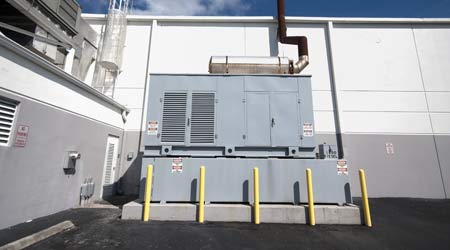Understanding Backup Power Generation System Options
The main purpose of backup power is to improve power reliability. But there are some exceptions — reducing peak demand, for one.
The main purpose for backup power generation (that is, equipment that is normally off and in standby mode) is to improve power reliability. Backup systems quickly restore and keep parts of or all of the facility or campus powered up for minutes, hours, or days if (when) normal utility power fails for more than a few seconds. Backup systems can be operated specifically to reduce utility power costs in particular cases, as reviewed later in this article, but this approach can reduce reliability.
Diesel engine generators are by far the most common choice for backup power systems. Until recently, the only other viable backup power option was natural gas engine generators. Prime power technologies, including solar, fuel cells, large gas turbines, and small gas microturbines, are difficult to apply for standby backup. Diesel engines start and spin up fast and provide a low-impedance or “stiff” source for sudden load application and redundancy failovers; it is challenging to achieve this performance with other generation sources, especially solar and fuel cells. A stiff source is required to maintain frequency and voltage during sudden, large load applications, and to provide torque for starting large motors, chillers, etc.
The vast majority of onsite diesel and gas generators that most facility managers deal with are strictly used for backup power, code-required “emergency” (for healthcare facilities and other life-safety requirements) or “optional standby” (for data centers, call centers, etc.). This equipment is not normally rated for prime (very long-term) or continuous operation, and it is rarely cost-effective to operate it more than necessary during emergencies. Utilities have traditionally been able to generate and distribute power at such scale that (relatively) small onsite equipment simply cannot compete. And even if the equipment could be operated cost-effectively, emissions from the combustion of fossil fuels is increasingly an issue, especially in areas with large urban concentrations like Southern California. Biofuel alternatives to diesel are available, but extra care is required to avoid injector clogging and other issues that might reduce reliability.
It is rarely cost-effective to operate a backup diesel generator to augment or replace utility power, strictly for the goal of reducing utility power costs. The cost of the fuel will almost always exceed the utility cost savings.
Reducing peak
One exception, however, would be to reduce peak demand charges during anticipated high loading lasting more than 15 minutes, such as during load-bank testing equipment downstream of the generator. For example, if a facility needs to load-bank-test a 500 kW UPS system for a couple of hours, operating the UPS (and other connected loads) from the generator source during most or all of the testing could eliminate a significant peak demand charge from the utility during the monthly or annual billing cycle. Take the time to understand the nuances of the utility rate structure to manage peak demand charges and avoid costly surprises.
Some electric utilities have programs with incentives to remotely control and operate an owner’s backup power generator (typically diesel or natural gas engines) to handle local or regional peak demand. Portland General Electric and Duke Energy are among utilities with such programs. Incentives may include the utility providing much or all of the generator maintenance and testing for the owner. Drawbacks may include complex switchgear and remote (utility) control of owned assets.
The reason that such programs exist is that utilities want to sell base power: steady, continuous or slowly and predictably changing loads; the base power load justifies the investment in generation plants and power transmission and distribution. Utilities prefer not to sell peak power, which requires over-sized transmission and distribution and rapid spin up and wind down of older, smaller, less-efficient, and often highly-polluting “peaker” generating plants. And utilities don’t want to stress their power lines and transformers during heat waves that often coincide with peak power demand, for obvious reasons (failures, complaints, service requests, emergency repair costs, etc.).
Several versions of utility incentive programs exist. These include simple, lower “interruptible” rates, where a utility power shutdown warning is typically provided in advance, to more complex arrangements where the utility can operate a facility’s generator in parallel with the utility and use the otherwise stranded capacity of that generator. During a power outage, most backup generators — serving a hospital or a data center, for example — are actually loaded at less than 50 percent capacity. But with the more complex utility arrangement, the backup generator operated in parallel with and connected to the utility may be loaded to 80 percent or 90 percent of capacity, to cover the facility load plus feed power back to the local grid. If reliability is the main objective, understand that, during the time onsite power generation operates connected to and in parallel with the utility, even during brief closed-transition transfers, there is single-point failure risk. A failure in one source can pull down the other, or cause shutdowns or breakers to trip in the act of self-protection.
Related Topics:
















